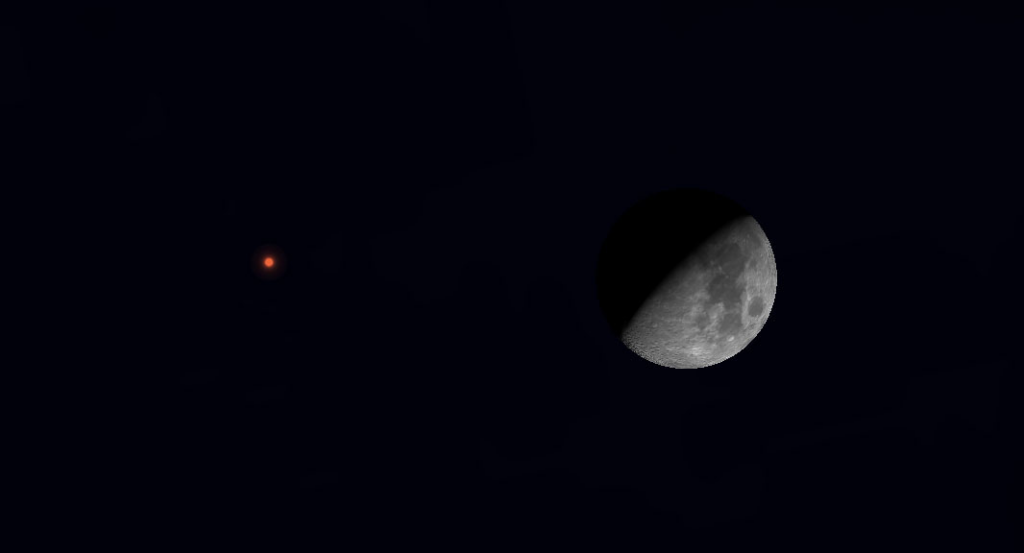Sky Report: February 27 – March 5

At 7 p.m. on the 27th, Mars is two moon-diameters to the left of the moon. Mars is just a dot compared to the moon. They’re closer later in the evening when Mars is less than one moon-diameter below the moon. Graphic created with SkySafariAstronomy.com.
We’ve had a string of wonderful conjunctions recently, all in the evening sky, and you could be forgiven for thinking that nice conjunctions are common and no big deal. But we’ve had the three brightest planets in the evening sky plus Saturn, so conjunctions were inevitable. But that’s ending.
There are two conjunctions this week that would be well-worth getting up at 4 a.m. to see, but they both happen in the evening. How convenient!
The first is between the moon and Mars on the 27th.
The moon and planets are all moving, each at its own speed, but the moon travels fastest, completing a circuit of the sky once each month. Its speed against the background of stars is 13° per day, so conjunctions are one-night affairs. You’ve been watching the moon approach Mars. The moon catches and passes Mars on the 27th, and they are so close all night that people with binoculars or wide-angle telescopes will see them together. The moon’s orbital motion carries it toward, past, and away from Mars (and everything else) at the rate of ½° per hour. At 7 p.m., when the moon and Mars are at their highest and nearly overhead, they are separated by 1-1/5°. The moon moves slightly closer and they’re closest at around 11 p.m., when their centers are separated by 1/2° and Mars is below the moon. Then they slowly separate.
This is as seen from southern Utah and northern Arizona. Parallax (Google it) causes them to appear closer or farther apart from different parts of the earth; from Scandinavia the moon will occult, or cover Mars. But from the western US their separation appears roughly the same.
The moon and Mars are in Taurus, north of Orion.
The moon will pass Mars again once each month this spring and summer but it won’t come so close.
Meanwhile the two brightest planets, Jupiter and Venus, form a very pretty pair in the west. You’ve watched Venus move toward Jupiter for weeks, and as this week begins, on the 27th, Venus is a scant 2° below Jupiter. On the 28th their separation has decreased to only 1¼° and the two appear together in a wide-angle telescope. This would be a wonderful conjunction everyone would want to see, but Venus continues on its path to the right of Jupiter, and on March 1 Venus is precisely ½° — or the width of the moon – to the right of Jupiter, and you could cover the two planets with your thumbnail held at arm’s length. You’ll see them both together through any telescope. They won’t be this close together until 2027. Note Jupiter’s moons extending upward; from Jupiter they are Io, Ganymede, and Callisto (Europa is behind Jupiter).
On the following night Venus is 1° above Jupiter, still a wonderful conjunction, and on the 4th almost 2° above – still wonderful – until Venus leaves Jupiter far behind. Be watching each night!
The Sky Report is presented as a public service by the Stellar Vista Observatory, a nonprofit organization based in Kanab, Utah, which provides opportunities for people to observe, appreciate, and comprehend our starry night sky. Additional information is at www.stellarvistaobservatory.org. Send questions and comments to John@StargazingAdventures.org.






Comments are closed.